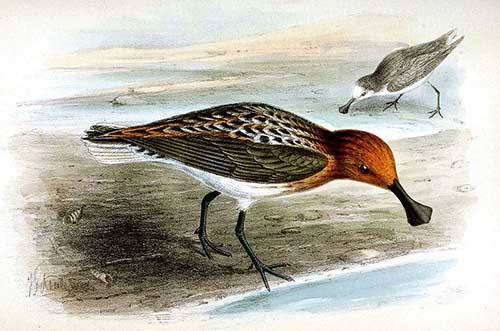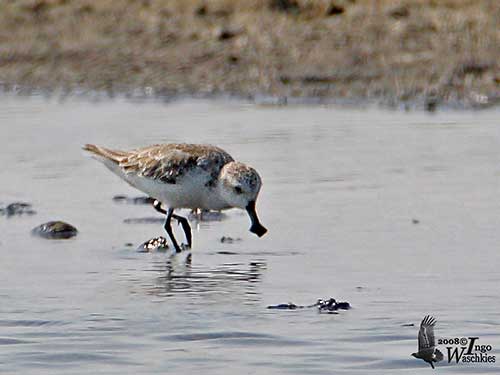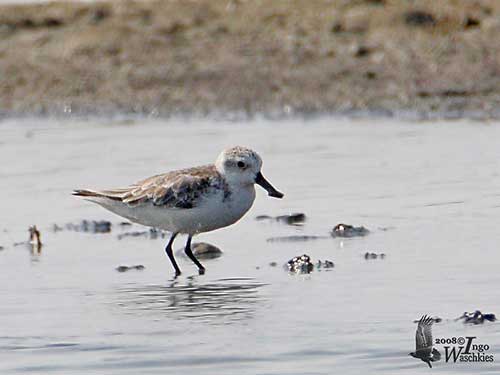
Fr: Bécasseau spatule
Ang: Spoon-billed Sandpiper
All: Löffelstrandläufer
Esp: Correlimos Cuchareta
Ita: Gambecchio becco a spatola
Nd: Lepelbekstrandloper
Sd: Skedsnäppa
Photographer:
Ingo Waschkies
Bird Photography
Illustration:
John Gerrard Keulemans (1842-1912)
Spoon-billed Sandpiper, Eurynorhynchus pygmeus, lithograph – 1869
Text by Nicole Bouglouan
Sources:
HANDBOOK OF THE BIRDS OF THE WORLD Vol 3 by Josep del Hoyo-Andrew Elliott-Jordi Sargatal - Lynx Edicions - ISBN: 8487334202
SHOREBIRDS by Peter Hayman, John Marchant and Tony Prater – Christopher Helm – 1986 – ISBN: 0747014035
GUIDE DES LIMICOLES de D. Taylor - Delachaux et Niestlé - ISBN : 2603014080
L’ENCYCLOPEDIE MONDIALE DES OISEAUX - Dr Christopher M. Perrins - BORDAS - ISBN: 2040185607
What Bird-The ultimate Bird Guide (Mitchell Waite)
Wikipedia, the free encyclopaedia
All About Birds (Cornell Lab of Ornithology)
Spoon-billed Sandpiper
Eurynorhynchus pygmeus
Charadriiformes Order – Scolopacidae Family
INTRODUCTION:
The Spoon-billed Sandpiper has its own genus Eurynorhynchus, in the subfamily Calidrinae within the large family Scolopacidae. This species shows very peculiar morphological feature. It has a spatulate bill very similar to those of spoonbills (genus Platalea). This expansion of the bill increases the size of the tactile surface and enhances the detection of the small prey eaten by this shorebird. The spatulate bill is very useful in soft sediments and shallow water where the bird is usually foraging.
The Spoon-billed Sandpiper is migratory. It breeds along the sea coasts of extreme NE Siberia, and winters S, migrating down the Pacific coast to S and SE Asia.
This species is listed as Critically Endangered with very small population. It is threatened by habitat loss through human developments, disturbance at breeding grounds, pollution and predation.
DESCRIPTION OF THE BIRD:
Biometrics:
Length: 14-16 cm
Weight: M: 29-30 g – F: 34 g
The Spoon-billed Sandpiper in breeding plumage has chestnut-red head, neck and breast with dark brown streaks. There is some white feathering around the bill base and the chin is white. The lores are mostly dark, extending through and behind the eye in narrow, dark eye line.
On the upperparts, mantle, scapulars and tertials show feathers with black-centres and chestnut fringes. The white-edged feathers of mantle may form indistinct whitish lines.
The flight feathers are mostly blackish. The white tips of greater coverts and the white bases of secondaries and inner primaries form a broad white wingbar visible on spread wings.
The central uppertail-coverts are black but the sides are white. The central rectrices are black while the outer tail feathers are pale grey.
The unique, spatulate bill is black, with flattened and expanded tip. The eyes are dark brown, surrounded by narrow, white eyering. Legs and feet are black.
The female has similar plumage but she is slightly larger than male.

The non-breeding adult has pale brownish-grey crown and upperparts with narrow darker streaks. The hindneck is much paler. The wing-coverts are grey with narrow white edges.
Forehead, supercilium, cheeks and underparts are white, with indistinct grey-brown streaking on neck sides and upper breast.
The juvenile has blackish-brown upperparts with pale fringes, often V-shaped at the edge of mantle and upper scapulars. The wing-coverts are brown with pale fringes. The underparts are white with buff wash on breast sides.
On the head, the crown is dark brown with chestnut fringes. Forehead and supercilium are creamy-white. The lores are dark, and there is a dark patch on the ear-coverts. The bare parts are like in adults.
RANGE:
The Spoon-billed Sandpiper breeds on Chukotskiy Peninsula, S to N Kamchatka. It winters S in Bangladesh, Myanmar and Thailand. It also winters locally from SE India and Sri Lanka to Indochina and S China, and S to Singapore and Philippines.
HABITAT:
The Spoon-billed Sandpiper breeds in coastal tundra, usually in grassy areas near lakes and marshes. It winters on coastal lagoons or muddy coasts without vegetation, and on sandy shores in Japan. It forages in sandy intertidal mudflats and small pools left by the tides.
CALLS AND SONGS: SOUNDS BY XENO-CANTO
The Spoon-billed Sandpiper gives a quiet “preeep” followed by a shrill “wheer” as contact call. During the aerial displays, the male gives a cicada-like descending buzzing trill “preer-prr-prr”.
BEHAVIOUR IN THE WILD:
The Spoon-billed Sandpiper feeds largely on insects during the breeding season, including beetles, Hymenoptera and Diptera. It also takes seeds, beetle larvae and small aquatic gastropods.
During winter, it feeds on worms, small red crabs, amphipods and tiny gastropods.

It forages in shallow water and muddy areas, using its unique bill to find prey. It uses several feeding techniques while walking with head down and sweeping from side to side with slightly open bill, or turning back without raising the bill. It also pecks at the substrate in rapid, repeated movements. It may also push its bill into the muddy sand in coastal areas.
The spatulate bill detects the prey by touch. Once the prey is caught, the bird uses both tongue and lamellae to filter out the prey from mud or water.
The Spoon-billed Sandpiper is usually monogamous for more than a single season. It is territorial at the breeding sites. The male establishes the territory usually in the same area each year.
The male performs a flight display with brief hovers while singing, circling and diving rapidly. Mating occurs on the ground where some displays are performed with raised wings.
The Spoon-billed Sandpiper is migratory. The adults migrate from July to late August, while the juveniles move from early August to mid-October. The usual stopovers are S Sakhalin and W Kamchatka. The return migration to N occurs in late May to early June through E Russia.
This species has rapid flight with fast wingbeats.
REPRODUCTION OF THIS SPECIES:
The breeding season takes place in June-July. The Spoon-billed Sandpiper nests on the ground, among mosses, sedges and creeping osiers. The shallow depression is lined with leaves, usually of dwarf willows. This species produces a single brood per season, but a replacement clutch is usually laid if the first brood is lost.
The female lays 4 buffy-white eggs with rufous-brown markings, making them very cryptic and almost invisible on the ground. Both adults share the incubation during 19-23 days. At hatching, the chicks are brown with dark and white mottling and spotting above, while the underparts are greyish-white. Their bill is a shorter version of adult’s bill.
Both parents tend the chicks, but the female leaves them 4-6 days after hatching. The male tends them alone and abandons them when they are 15-20 days old.
The young birds are preyed upon by Arctic Fox, skuas, stoats and ground squirrels. The survival of young birds is extremely low and is probably the main cause of declines.

PROTECTION / THREATS / STATUS:
The Spoon-billed Sandpiper is threatened by habitat loss through changes and degradation in the habitat for industry, aquaculture and wind farms (in Asia). Illegal hunting, pollution and human disturbance at nesting sites often involve high levels of nest desertion, and the natural predation affects the small population.
The global population is estimated at 240/400 mature individuals, equating to 360/600 individuals in total, but it is probably smaller than this estimate.
The Spoon-billed Sandpiper is listed as Critically Endangered with still declining population.